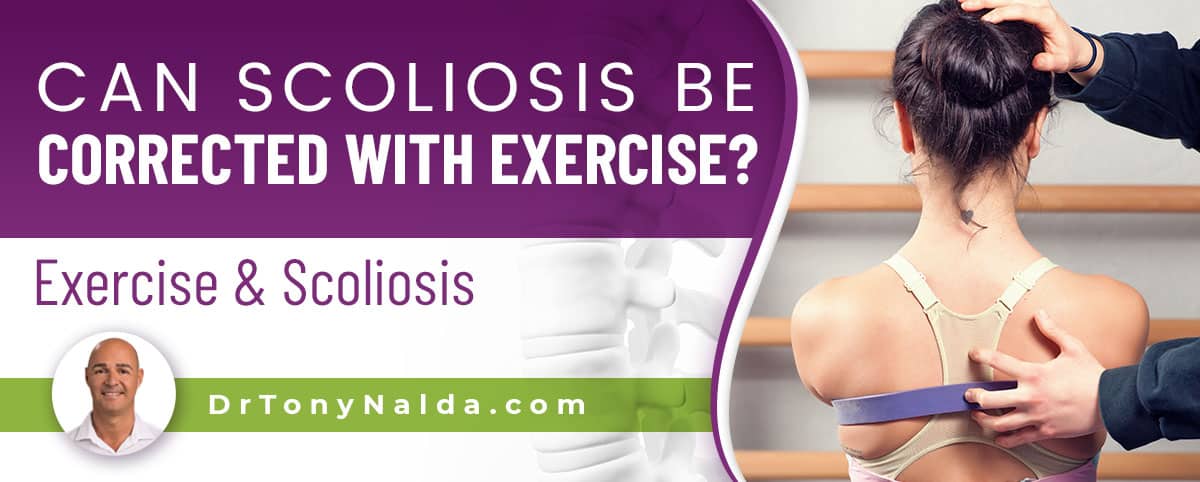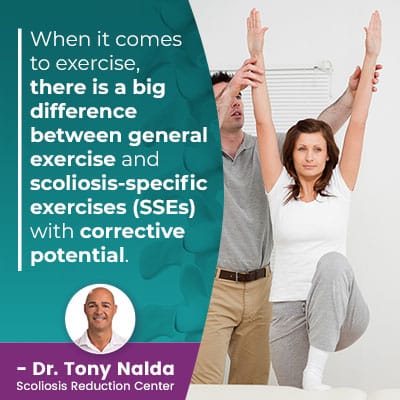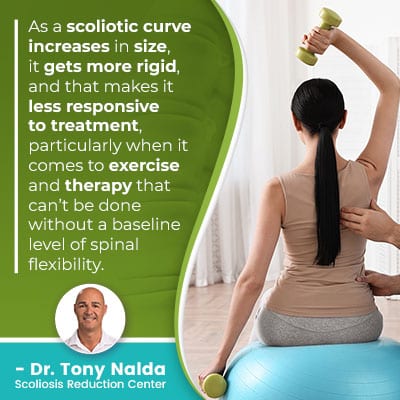Can Scoliosis Be Corrected With Exercise? Exercise & Scoliosis

As a progressive spinal condition, scoliosis can’t be cured, but it is highly treatable. When multiple condition-specific treatment modalities are integrated into a proactive treatment plan, scoliosis-specific exercise can be a valuable aspect of treatment.
While there was a time when the place of exercise in scoliosis treatment was questioned, the distinction between general and scoliosis-specific exercises (SSEs) is key. When combined with other forms of proactive treatment, SSEs can help achieve corrective results.
Let’s start our discussion on scoliosis and exercise by first talking generally about the condition itself.
Table of Contents
What is Scoliosis?
Scoliosis is a highly-prevalent spinal condition, with current estimates at close to 7 million people living with it in the United States alone; it is also the leading spinal condition among school-aged children.
Scoliosis involves the development of an unnatural sideways spinal curve, with rotation, and it’s the rotational element that makes it a 3-dimensional condition, as, in addition to bending to the side, the spine also twists from front to back, back to front.
The unnatural spinal curve also has to be of a minimum size to be considered scoliosis: Cobb angle of 10 degrees.
Cobb angle is known as the orthopedic gold standard in the assessment of scoliosis, and a patient’s Cobb angle is taken during X-ray by drawing intersecting lines from the tops and bottoms of the curve’s most-tilted vertebrae, and the resulting angle is expressed in degrees.
Cobb angle classifies conditions in terms of severity and shapes the crafting of effective treatment plans:
- Mild scoliosis: Cobb angle measurement of between 10 and 25 degrees
- Moderate scoliosis: Cobb angle measurement of between 25 and 40 degrees
- Severe scoliosis: Cobb angle measurement of 40+ degrees
- Very-severe scoliosis: Cobb angle measurement of 80+ degrees
The higher the Cobb angle, the more severe the condition, the more noticeable its symptoms are likely to be, and the more misaligned the spine is.
Along with condition severity, patient age, curvature location, and condition type (cause), further classify the condition to streamline the treatment process and guide treatment.
Scoliosis correction in adults often presents distinct challenges compared to addressing the condition in younger individuals. Many wonder, "Can you fix scoliosis?" and the answer is multifaceted. While it might not be possible to fully reverse scoliosis naturally, especially in its severe forms, there are certain methods that can help manage and reduce its symptoms. Chiroprators play a pivotal role in this by offering specialized adjustments and treatments tailored to scoliosis patients. They can also provide guidance on scoliosis exercises to avoid, ensuring that individuals do not inadvertently exacerbate their spinal curvature. Through a combination of chiropractic care and mindful physical activity, adults can work towards alleviating the impacts of scoliosis in their lives.
So now that we’ve defined the condition and the parameters that have to be met in order to meet a scoliosis diagnosis, let’s talk about treatment and the role of exercise.
Can Scoliosis Be Corrected with Exercise?
Firstly, let’s discuss the difference between curing scoliosis and correcting it; it’s an important distinction to understand.
Scoliosis is a progressive condition, meaning it’s in its very nature to worsen over time, particularly if left untreated or not treated proactively.
 So scoliosis is going to get worse at some point: it’s virtually guaranteed.
So scoliosis is going to get worse at some point: it’s virtually guaranteed.
Where scoliosis is at the time of diagnosis is not indicative of where it will stay; only proactive treatment that works towards counteracting the condition’s progressive nature can manage progressive rates.
As a progressive condition, scoliosis is incurable, so when we say correct, in the context of scoliosis, what we mean is achieving corrective results.
Corrective results mean impacting the condition on a structural level, in the form of a curvature reduction, and here at the Scoliosis Reduction Center, I use a conservative chiropractic-centered treatment approach to impact conditions on every level.
The complex nature of scoliosis necessitates a customized and integrative approach to treatment; no one treatment discipline on its own, exercise included, is powerful enough to impact scoliosis on the different levels needed for sustainable long-term treatment results.
When multiple treatment disciplines, exercise included, are combined, they can complement one another and augment corrective results.
Many individuals wonder if scoliosis can be corrected or cured with exercise, aiming to address their condition without surgery. While exercise can play a role in managing scoliosis, it's important to understand that exercise alone may not cure scoliosis naturally.
The effectiveness of scoliosis correction through exercise can vary depending on factors like the degree of spinal curvature, age, and individual response to treatment. Consulting with a healthcare professional can help assess scoliosis treatment options, potential costs, and whether exercise can be a part of a comprehensive approach to managing the condition in adults and younger individuals alike.
When it comes to exercise, there is a big difference between general exercise and scoliosis-specific exercises (SSEs) with corrective potential.
General Exercise vs. Scoliosis-Specific Exercise
The place of exercise in scoliosis treatment was questioned for many years, but that was because the studies and research were focusing on the wrong type of exercise: general exercise.
Just as scoliosis is too complex to be addressed with general chiropractic care, requiring condition-specific techniques, augmenting correction is beyond the scope of general exercise and requires the integration of scoliosis-specific exercises and therapies into treatment.
In addition to using chiropractic care to manually adjust the position of the curve’s vertebrae so they are better aligned with the rest of the spine, impacting the condition on a structural level, I also help patients work towards increasing their core strength. This is important because it’s not just the spine that’s in charge of maintaining its natural curves and alignment but also its surrounding muscles.
When combined with other forms of corrective treatment, SSEs can target the core muscles, so the spine is optimally supported, and in addition, they can also be used to address muscle imbalances that develop as they struggle to support an unnaturally-curved spine.
In addition, certain SSEs are also known to activate specific areas of the brain for improved brain-body communication, postural remodeling, and better body positioning.
Exercises to Help Scoliosis
An issue that develops as scoliosis progresses is spinal rigidity.
 As a scoliotic curve increases in size, it gets more rigid, and that makes it less responsive to treatment, particularly when it comes to exercise and therapy that can’t be done without a baseline level of spinal flexibility.
As a scoliotic curve increases in size, it gets more rigid, and that makes it less responsive to treatment, particularly when it comes to exercise and therapy that can’t be done without a baseline level of spinal flexibility.
Particularly common in my adult patients who have already experienced significant progression over time, I often have to do some preparatory work to increase spinal flexibility so patients have the ability to perform prescribed exercises and stretches and their spines are more responsive to treatment in general, including chiropractic care.
While each case is different and will require the design of its own customized exercise regime and no type of exercise or activity should be attempted before a patient’s treatment provider clears it, the following exercises are known to help with scoliosis.
A hip flexion stretch, child’s pose, pelvic tilt, latissimus dorsi stretch, and the abdominal press can help by:
- Opening up the hips to keep them as loose as possible
- Lengthening and stretching the spine (can counteract compression)
- Stretching tight hip and lower back muscles
- Relieving back tension
- Strengthening abdominal muscles for optimal spinal support
Here at the Center, exercise is one component of a multifaceted treatment approach, including condition-specific chiropractic care, in-office therapy, corrective bracing, and custom-prescribed home exercises.
After the most intense portion of treatment has produced structural results and increased muscle strength for spinal support, I prescribe a series of custom exercises to establish a home-rehabilitation program for further stabilizing the spine for sustainable long-term results.
Inversion tables for scoliosis may offer some relief from discomfort and muscle tension, but they are not a standalone solution for correcting scoliosis. Scoliosis management typically involves a comprehensive approach, which may include exercises, bracing, or in severe cases, surgical intervention, under the guidance of a healthcare professional.
So, now that we’ve touched on how certain exercises can help achieve corrective results, let’s briefly address the types of exercise that people with scoliosis should avoid.
Exercises to Avoid When Having Scoliosis
So, again, while general exercise can help with general fitness and overall health, in order to have corrective potential, it needs to be scoliosis-specific, prescribed by a scoliosis specialist, and combined with other forms of effective scoliosis treatment.
So exercises to avoid with scoliosis will depend on what the expectation is; for those wanting to impact their scoliosis on a corrective level, general exercises won’t be particularly helpful.
In addition, there are certain exercises and stretches that people with scoliosis should avoid because they are known to exacerbate symptoms, interfere with treatment, and strain the spine unnaturally by exposing it to adverse tension.
Exercises and stretches that overuse one side of the body (golf, tennis) are particularly bad for scoliosis because it plays into the condition’s asymmetrical effects; the uneven forces of the condition disrupt the body’s overall symmetry, causing postural deviation as the main visual symptom.
Exercises and stretches that are known to worsen scoliosis symptoms are those that keep the cervical spine bent forward, as this increases the weight of the head on the neck, shoulders, and upper back (diving).
Exercises and activities that expose the spine to repeated jarring motions, such as running, horseback riding, and long jump, are not ideal for people with scoliosis because the spine is already facing compression from the unnatural spinal curve.
Repeatedly hyperextending the torso, as in ballet, gymnastics, and certain yoga poses, can strain the thoracic spine and abdomen, which can impair their ability to support and stabilize the spine adequately.
Conclusion
So can scoliosis be corrected with exercise? On its own, no form of treatment is enough to impact the condition on every level the way it needs to be, and that includes exercise.
While exercise can play a crucial role in scoliosis treatment, especially for those with mild scoliosis or uneven hips, it's important to differentiate between functional and structural scoliosis, as exercise may help straighten the spine naturally in functional cases, but has limited corrective ability in structural scoliosis.
However, when multiple condition-specific treatment modalities are combined and integrated into a proactive conservative treatment plan, there are fewer limits to what we can achieve, and scoliosis-specific exercise can augment corrective results.
Here at the Center, I combine chiropractic care, in-office therapy, corrective bracing, and custom-prescribed home exercises so that, first and foremost, the condition is impacted on a structural level in the form of a curvature reduction, and once I see structural results, I can shift the focus to using bracing, exercise, and a variety of therapies to increase core strength and further stabilize the spine.
Dr. Tony Nalda
DOCTOR OF CHIROPRACTIC
After receiving an undergraduate degree in psychology and his Doctorate of Chiropractic from Life University, Dr. Nalda settled in Celebration, Florida and proceeded to build one of Central Florida’s most successful chiropractic clinics.
His experience with patients suffering from scoliosis, and the confusion and frustration they faced, led him to seek a specialty in scoliosis care. In 2006 he completed his Intensive Care Certification from CLEAR Institute, a leading scoliosis educational and certification center.
About Dr. Tony Nalda
 Ready to explore scoliosis treatment? Contact Us Now
Ready to explore scoliosis treatment? Contact Us Now





